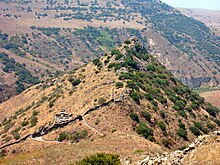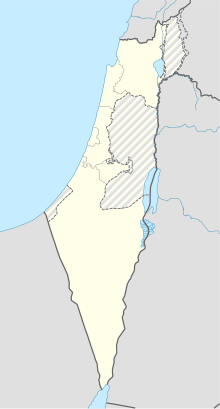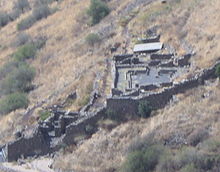This is an old revision of this page, as edited by Supreme Deliciousness (talk | contribs) at 16:04, 19 December 2010 (Jews moved in there later.). The present address (URL) is a permanent link to this revision, which may differ significantly from the current revision.
Revision as of 16:04, 19 December 2010 by Supreme Deliciousness (talk | contribs) (Jews moved in there later.)(diff) ← Previous revision | Latest revision (diff) | Newer revision → (diff) This article is about the ancient city in the Golan Heights. For Stockholm's Old Town, see Gamla stan.| This article has multiple issues. Please help improve it or discuss these issues on the talk page. (Learn how and when to remove these messages)
No issues specified. Please specify issues, or remove this template. (Learn how and when to remove this message) |
 Ruins of Gamla Ruins of Gamla | |
 | |
| Location | Golan Heights |
|---|---|
| Site notes | |
| Ownership | |
| First Jewish–Roman War | |||||||||||
|---|---|---|---|---|---|---|---|---|---|---|---|
| |||||||||||
Gamla was an ancient city in the Golan Heights. Inhabited since the Early Bronze Age, it is believed to have been founded as a Seleucid fort during the Syrian Wars. The site of a Roman siege during the Great Revolt of the 1st century CE, Gamla is a symbol of heroism for the modern state of Israel and an important historical and archaeological site. It currently resides within the Gamla nature reserve and is a prominent tourist attraction.
History
Situated at the southern part of the Golan, overlooking the Sea of Galilee, Gamla was built on a steep hill shaped like a camel's hump, from which it derives its name (Gamla meaning 'camel' in Aramaic). The city appears to have been founded as a Seleucid fort during the Syrian Wars (3rd century BC) which later became a civilian settlement. Jews inhabited it from the last quarter of the 2nd century BC, and it was annexed to the Hasmonean state under king Alexander Jannaeus in c. 81 BC.
Josephus Flavius, Commander of Galilee during the Jewish Revolt against Rome, in 66 AD fortified Gamla as his main stronghold on the Golan. Josephus gives a very detailed topographical description of the city and the steep ravines which precluded the need to build a wall around it. Only along the northern saddle, at the town's eastern extremity, was a 350 meters-long wall built. It was constructed by blocking gaps between existing houses and destroying houses that lay in its way.
Initially loyal to the Romans, Gamla turned rebellious under the influence of refugees from other locations. It was one of only five cities in the Galilee and Golan who stood against Vespasian's legions, reflecting the cooperation between the local population and the rebels. At the time of the revolt, the town minted its own coins, probably more as a means of propaganda than as currency. Bearing the inscription "For the redemption of Jerusalem the H(oly)" in a mixture of paleo-Hebrew (biblical) and Aramaic, only 6 of these coins have ever been found.
Josephus also provides a detailed description of the Roman siege and conquest of Gamla in 67 AD by components of legions X Fretensis, XV Apollinaris and XV Macedonica. The Romans first attempted to take the city by means of a siege ramp, but were repulsed by the defenders. Only on the second attempt did the Romans succeed in breaching the walls at three different locations and invading the city. They then engaged the Jewish defenders in hand-to-hand combat up the steep hill. Fighting in the cramped streets from an inferior position, the Roman soldiers attmpted to defend themselves from the roofs. These subsequently collapsed under the heavy weight, killing many soldiers and forcing a Roman retreat. The legionnaires re-entered the town a few days later, eventually beating Jewish resistance and completing the capture of Gamla.
According to Josephus, some 4,000 inhabitants were slaughtered, while 5,000, trying to escape down the steep northern slope, were either trampled to death, fell or perhaps threw themselves down a ravine. These appear to be exaggerated and the number of inhabitants on the eve of the revolt has been estimated at 3,000 - 4,000. The notion that these inhabitants committed mass suicide has also been questioned, as the account appears to force an analogy with the story of the end of the siege of Masada, also recounted by Josephus. The Greek word Josephus used implies a hasty, clumsy flight while suicide is forbidden under most circumstances by Jewish law.
Excavations
Abandoned after its destruction, Gamla was identified in 1889 by Konrad Furrer with the site of Tel ed-Dra', in the Rukkad river-bed. It was only properly identified in 1968 by surveyor Itzhaki Gal, after the Israeli conquest of the Golan Heights during the Six Day War. It was excavated by Shemaryahu Gutmann and Danny Sion on behalf of the Israeli Department of Antiquities between 1978 and 2000. The excavations have uncovered 7.5 dunnams, about 5% of the site, revealing a typical Jewish city featuring ritual baths, Herodian lamps, limestone cups and thousands of Hasmonean coins.
The Gamla excavations also revealed widespread evidence for the battle that took place at the site. About 100 catapult bolts have been uncovered, as well as 1,600 arrowheads and 2,000 ballista stones, the latter all made from local basalt. This is a quantity unsurpassed anywhere in the Roman Empire. Most were colleced along and in close proximity to the wall, placing the heavy fighting in the vicinity and the Roman siegecraft to the north east of the town. Next to a heavy concentration of the stones, the excavators have identified a man-made breach in wall, probably made by a battering ram.
About 200 artifacts excavated at Gamla have been identified as the remains of Roman army equipment. These include parts of Roman lorica segmentata, an officer's helmet visor and cheek-guard, bronze scales of another type of armor, as well as Roman identification tags. A Roman siege-hook, used both for stabbing and hooking onto the wall, was found in the breach.
Only one human jawbone was identified during the exploration of Gamla, raising questions regarding the absence of human remains despite the widepsread evidence of a battle. A tentative answer is discussed by archaeologist Danny Syon, who suggests that the dead would have been buried at nearby mass graves that are yet to be found. One such mass grave has been found at Yodfat, which had suffered the same fate as Gamla at the hands of Vespasian's legions.
Artifacts from Gamla are on the display at the Golan Archaeological Museum, including arrowheads, ballista stones, clay oil lamps and coins minted in the town during the siege. A scale model and film are used to describe the conquest and destruction of the Jewish town and all of its inhabitants.
Synagogue

Inside the city walls stood a large synagogue, built of dressed stone with pillared aisles. Measuring 22 * 17 meters, its main hall was surrounded by a Doric colonnade, its corner columns were heart-shaped, and it was entered by twin doors at the south west. A public ritual bath was unearthed next to it. On the eve of Gamla's destruction the synagogue appears to have been converted to a dwelling for refugees, as testified by a number of meager fireplaces and large quantities of cookpots and storage jars found along its northern wall. Situated next to the city wall, 157 ballista stones were collected from the synagogue's hall alone and 120 arrowhead from its vicinity. The synagogue is thought to date from the late 1st century BC and is among the oldest synagogues in the world.
Present-day Gamla
Today Gamla is an archaeological site and a nature reserve. It is also home to a large nesting population of Griffon vultures. The nature reserve also contains some 700 Neolithic Dolmens, several of which can be viewed from the entry road.
See also
Gallery
-
 1975 Archaeological expedition
1975 Archaeological expedition
-
 Ruined city of Gamla
Ruined city of Gamla
-
 The breach in the wall of Gamla
The breach in the wall of Gamla
-
 The Gamla vulture look-out
The Gamla vulture look-out
References
Notes
- Israel Nature and Parks Authority
- ^ Berlin and Overman (2002), p. 152
- ^ Syon, Danny. "Gamla - The Archaeological Evidence of the Revolt at Gamla". Israel Antiquities Authority. Retrieved October 16, 2010.
- Josephus, Antiquities of the Jews 13, 394.
- Josephus, The Wars of the Jews 2, 574.
- ^ Aviam, Mordechai (2007). "The Archaeological Illumination of Josephus' Narrative of the Battles at Yodefat and Gamla". In Zuleika Rodgers (ed.). Making history: Josephus and historical method. Brill. pp. 372–384. ISBN 9004150080.
- ^ Rocca (2008), p. 40
- Rocca (2008), p. 43
- ^ Josephus, The Wars of the Jews 4, 1-83.
- Rocca (2008), p. 49
- ^ Weiss, Zeev, "Jewish Galilee in the First Century C.E.: An Archaeological View", in Schwartz, Daniel R. (ed.), Flavius Josephus, Vita: Introduction, Hebrew Translation, and Commentary (in Hebrew), Jerusalem: Yad Ben-Zvi Press, pp. 15–60
- Ashkenazi, Eli (June 17, 2008). "What are the mysterious stones emerging from Kinneret waters?". Haaretz. Retrieved October 16, 2010.
- Binder, Donald D. "Ancient Synagogues - Gamla". Retrieved October 16, 2010.
- Bronze Age Trilithon Dolmens, Gamla (photo)
Bibliography
- Berlin, Andrea M.; Overman, J. Andrew (2002). The First Jewish Revolt: Archaeology, History and Ideology. Routledge. ISBN 0415257069.
- Josephus, Flavius. William Whiston, A.M., translator (1895). The Works of Flavius Josephus – Antiquities of the Jews. Auburn and Buffalo, New York: John E. Beardsley. Retrieved 16 October 2010.
- Josephus, Flavius. William Whiston, A.M., translator (1895). The Works of Flavius Josephus – The Wars of the Jews. Auburn and Buffalo, New York: John E. Beardsley. Retrieved 16 October 2010.
- Rocca, Samuel (2008). The Forts of Judaea 168 BC – AD 73. Oxford, United Kingdom: Osprey Publishing. ISBN 978-1-8460-3171-7.
External links
- Gamla on the Israel Antiquities Authority website.
- Gamla on the Israel Nature and Parks Authority website.
- Ancient Jewish Roman history
- Classical sites on the Golan Heights
- Hasmoneans
- Hill forts
- History of Israel
- Tourism in Israel
- Jewish–Roman wars
- Mountain monuments and memorials
- Nature reserves in Israeli-occupied territories
- Populated places established in the 2nd century BC
- Depopulated places in the Land of Israel
- Former populated places on the Golan Heights